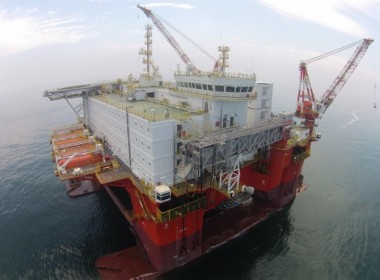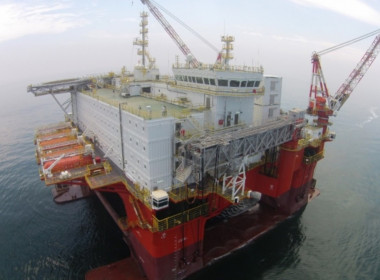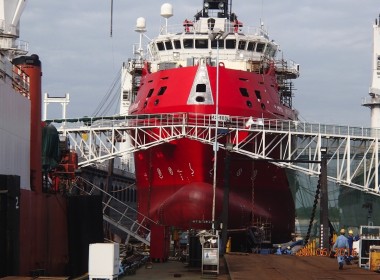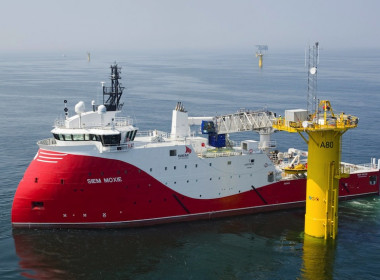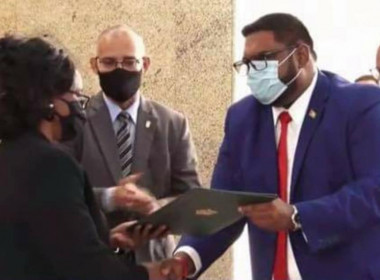COLUMN | Prosafe and Floatel International: restructured but not safe yet? [Offshore Accounts]

Last week, Norwegian floating accommodation provider Prosafe finally announced (here) some good news, albeit not for its shareholders, who are about to be wiped out. Like many other industry players, the operator of seven large, harsh-environment floatel units, has restructured its balance sheet by swapping debt for equity.
US$1.1 billion of loans to the company have been written off and exchanged for Prosafe shares. The banks and other lenders will now own 99 per cent of the company, when the transaction completes. Prosafe’s debt will shrink to just US$344 million, and it won’t have to pay back or roll over its remaining loans until December 2025.
Its board has threatened to use a Singaporean court-mandated scheme of arrangement to ensure that the process goes ahead, even if complete unanimity from its debt-holders is not forthcoming.
Unsustainable
The restructuring is long awaited and very necessary. In 2020, before the restructuring, Prosafe had spent US$62 million of interest costs on its US$1.4 billion of debts. After most of the debt is wiped out in the transaction, the company said it expected to benefit from massively reduced interest costs and debt service costs of just US$9 million annually.
The Covid crisis had hit Prosafe’s business especially hard. Whereas drilling rigs and offshore supply vessels fell to around 50 per cent utilisation in 2020, by the last quarter of last year, Prosafe was running at just 25 per cent utilisation, as clients cancelled North Sea maintenance projects. Its utilisation improved to only 26 per cent in the first three months of this year.
With most of its accommodation units idle, Prosafe has been bleeding cash from operations. It reported a US$10 million loss from operations in the first quarter of 2021.
Strategic headwinds
This was never going to end nicely for the shareholders, as Prosafe has faced strategic headwinds for the last six years. When the oil price collapsed in late 2014, the oil majors immediately slashed their maintenance budgets and reduced new projects, where Prosafe’s units had been used for commissioning support for both platforms and FPSOs.
This was unfortunate, as the collapse in demand coincided the delivery of Prosafe’s high-end, newbuilding units Safe Boreas, Safe Zephyrus and Safe Notos in 2015 and 2016. The company then doubled up on its hope-based strategy by announcing it had acquired Axis Offshore’s fleet of two newbuilds under construction in China, Novus and Vega, and the aged 1986-built monohull accommodation ship Dan Swift, which Prosafe took under commercial management only, renamed as Safe Swift. This unit is currently in Malta and its current charter status and ownership is not clear to me.
In 2019, Prosafe took delivery of Safe Euros, from Cosco Qidong shipyard in China.
The timing of Prosafe’s billion-dollar capital expenditure binge couldn’t have been worse.
Mexican blow
Since 2015 the company’s backlog of orders have fallen every year. Then in 2016, Pemex, the Mexican state oil company, which used to be a key end-user customer for Prosafe for many years, cancelled all requirements for non-Mexican accommodation vessels. This meant that Mexican player Cotemar was able to put its 2015 newbuild, 750 passenger, semi-sub floatels Atlantis and Neptuno to work there.
At the same time as the market tanked, new, international competition emerged, with Singapore’s POSH taking delivery POSH Xanadu and POSH Arcadia in late 2014 and early 2015, quickly winning contracts in Brazil and Australia. These rival POSH semi-subs featured a high accommodation capacity of 750 POB, a deck area of 1,800 square metres, large client workshops, two sizeable cranes, and a high sailing speed.
To exacerbate the situation, GranEnergia in Brazil also took delivery of two compact semi-submersible units from China, Olympia and Venus. Both of these accommodation vessels are also DP3 capable, and were purpose-built to execute maintenance, hook-up and commissioning and decommissioning projects for Petrobras, with a capacity for up to 501 people apiece. OOS Tiradentes was delivered from China in 2018 as well, another 600 POB accommodation semi-sub, also with DP3 system. Prosafe’s fleet was losing its lustre.
Competition authorities blocked merger
In early 2020, Prosafe’s effort to merge with the number two North Sea accommodation vessel provider, Floatel International, were aborted after objections from competition regulators in Norway and the UK. The two floatel companies had proposed an all-share merger in June 2019 in an effort to restructure their debts together, and create the world’s largest offshore accommodation company. When the merger was announced, the combined entity would have owned 14 offshore accommodation rigs.
Strategically this made sense. Unfortunately, both the British and Norwegian competition regulators opposed the deal because they feared the creation of a dominant player which would leave North Sea oil producers with fewer choices for accommodation and higher prices. So, the deal didn’t go ahead.
Courtroom defeat in Norway
Recent legal defeat has added to Prosafe’s woes. We have already covered how the best place to see the big names of the offshore industry is often in court (here and here).
Prosafe has been fighting the Norwegian shipyard Westcon over the expensive and delayed conversion of the accommodation vessel Safe Scandinavia for several years since the unit was renovated in 2016. Equipped with high and low pressure mud pumping, mixing and storage capabilities, Safe Scandinavia was upgraded to support wireline, coil tubing and cement services. The unit can also support rig-less well intervention or can be configured with a modular rig or platform derrick to undertake drilling or workover activities.
This is a great concept, but a shame that the owners and the shipyard couldn’t work out their differences without recourse to law.
Not so Safe Scandinavia, legally
In March 2018, the Stavanger District Court decided that Westcon must pay Prosafe NOK344 million (US$41 million) plus interest and legal costs. Unfortunately, Westcon filed an appeal, and Prosafe filed a counter-appeal in May 2018.
Then, in April this year, the Gulating Court of Appeal dropped a bombshell. Completely overturning the earlier decision in the lower court, it ruled that Prosafe must pay Westcon NOK302 million (US$36.3 million) plus interest and legal costs, in total around NOK465 million (US$56 million).
Prosafe described this as a “disappointing and surprising judgement,” and in May, Prosafe announced that it would appeal to the Norwegian Supreme Court. The fight continues.
Restructuring buys time
Prosafe has followed the formula of Solstad, Tidewater, Bourbon, McDermott, and all the American drillers in responding to the crisis. It suspended its dividend payments in 2015. The company announced 150 job losses on three of its accommodation vessels in 2019, IHS Markit reported here.
Prosafe took a massive impairment of US$810 million on its fleet in 2020, on top of the US$346 million impairment it reported in 2019. The impairments, low utilisation and high debt costs meant that the company lost US$400 million in 2019, and a whopping US$950 million in 2020. Shareholders knew that there was no value left, as by the end of 2020 the company had negative equity of over a billion US dollars and the directors had prefaced the 2020 annual report with a going concern warning that “as reported previously, a significant equitisation of debt is anticipated which in turn is likely to result in minimal or no recovery for current shareholders.”
Scrapping eight, including Regalia
Prosafe has shrunk its fleet; in January this year, it sold the 1985-built, semi-submersible floatel Regalia for scrapping and recycling, meaning that since 2016 Prosafe has sold eight accommodation units for razor blades, the largest fleet reduction in the floating accommodation industry.
New builds on ice, preserved in China
It has now deferred its newbuilding programme of the two 500-passenger, DP3 accommodation semi-submersibles it acquired when it bought Axis, Safe Vega and Safe Nova, as disclosed here. The two newbuilds were constructed at Cosco shipyard, Qidong, to an enhanced GM500A design. They feature both DP3 dynamic positioning and 10-point wire mooring “for flexible and efficient operations in the harshest offshore environments,” as well as cinemas for 188 people.
Prosafe’s agreement with Cosco shipyard allows for what the company described as “flexible delivery and long-term financing of Safe Nova and Safe Vega. Both vessels are nearing completion with a planned preservation and strategic stacking mode in the yard.”
This is exactly the strategy that Borr Drilling and Transocean have adopted with some of their final newbuilding rigs, buying time by stacking the ships and kicking back delivery.
So far, unfortunately, six years into the recession, the offshore recovery that might make these newbuilds economically viable for Prosafe has yet to emerge.
Floatel International: in the same boat
Prosafe’s restructuring was made inevitable when its merger with Floatel International failed last year, and then when Floatel managed to complete its own restructuring in March of this year (here).
The two companies had followed parallel paths – sinking order books, shrinking cash, and mounting debts. Like Prosafe, Floatel International took delivery of two expensive newbuildings, Floatel Triumph in 2016 and Floatel Endurance in 2015, just as day rates plunged and utilisation fell off a cliff. The newbuilding cycle in offshore accommodation has probably been the most mis-timed and ill-advised in the entire offshore industry.
In 2020, like Prosafe, Floatel International took impairment charges of US$479 million on its fleet as their values plunged.
In the restructuring, Floatel International managed to keep control of its existing fleet of five accommodation units (which were all built in 2010 or more recently), while substantially reducing its debt by US$610 million. The group also enhanced its liquidity position by securing a new US$100 million revolving credit facility, and said the transaction had dramatically reduced its debt service.
Floatel has a post restructuring indebtedness of US$200 million through two bond issuances and the US$100 million revolving credit facility.
Keppel keeps just under half
Those familiar faces at Keppel (here) retained 49.9 per cent ownership, the former bondholders now own 40.1 per cent, and the self-same Swedish management team of the company were rewarded with a 10 per cent stake, which seems remarkably high given the utter insolvency of the business prior to the restructuring and the debt for equity swap. We presume that this ten per cent stake is “sweat equity” for the sacrifices they made during the process.
How do the rest of us get some of that?
What does the future look like?
Whilst both Floatel International and Prosafe have managed to survive, albeit through the tried-and-trusted technique of defaulting on their debt and giving their lenders shares in the companies, their future is not assured.
The move to wind power means that new offshore energy projects are increasingly about smaller units providing maintenance to hundreds of wind turbines with a few dozen technicians, rather than one big accommodation unit providing hundreds of workers moored alongside a single platform or FPSO. Accommodation requirements offshore are becoming more numerous, but with fewer people and smaller ships.
Active heave compensated gangways are winning
The adoption of the active heave compensated gangways from Ampelmann, SMST, Safeway, Barge Master and Uptime (here), means that more and more operators are turning to much cheaper DP2 walk-to-work vessels to provide their day-to-day maintenance and commissioning requirements.
A recent shipbroker report by Braemar ACM on the walk-to-work market showed that there are now some fifty walk-to-work and service operations vessels working in the North Sea, typically with between only fifty and one hundred POB on board, rather than the three hundred to six hundred staff that Floatel International and Prosafe’s DP3 units can provide.
The relatively cheap walk-to-work gangway is fast making the US$200 million accommodation semi-sub redundant for all but the largest FPSO and platform commissioning and shutdown jobs. The lack of investment in oil and gas in the last few years further limits the opportunities like POSH’s long and high revenue contract in 2016 to support the commissioning of the Prelude FPSO for Shell in Australia (here).
Every owner of a DP2 subsea vessel can now fit an Ampelmann or equivalent gangway and become a floating accommodation provider.
Prosafe has survived, but will it flourish? Floatel International announced (here) on May 27 that it would support Ørsted in constructing its Greater Changhua 1 & 2a Offshore Wind Farms offshore Taiwan by providing construction support services, including accommodation and catering. Is this move into windfarm commissioning a trend that will be sustained?
Ironically, just as the accommodation specialists revel in owning the biggest, newest and most high-tech accommodation units with the most passenger capacity, the largest growth in accommodation is in the smaller, simpler DP2 ships from the likes of Vroon, Wagenborg, Esvagt, Seaways, Acta and Rem.
Sometimes, biggest isn’t best.
Background reading
Prosafe 2020 annual report is here.
Floatel International 2020 annual report is here.
For the triumph of hope over reality, see Prosafe’s 2018 investor update here – this features such gems as the company being “transformed and refinanced”, having “sufficient financial runway and flexibility” with signs that the “market [is ]picking up”.


